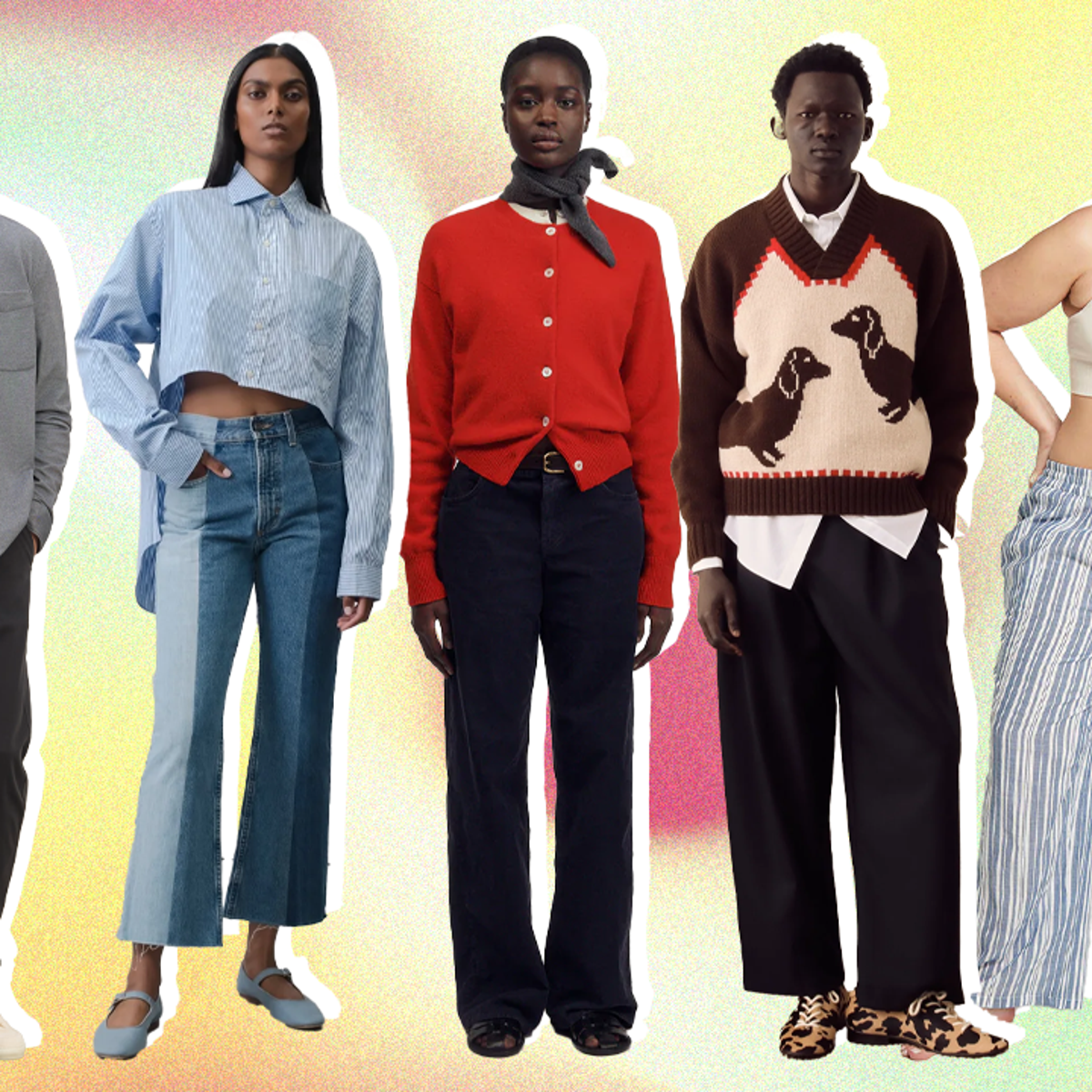How Sustainable Fabric Trends Are Shaping Branded Clothing Collections
Wiki Article
Understanding Apparel: The Value of Fabric Choices in Your Closet
The option of material in clothes plays an essential function in both looks and functionality. Various products provide varying levels of breathability, longevity, and comfort, directly affecting the user's experience. Understanding these subtleties can improve one's wardrobe markedly. Several overlook exactly how these choices can influence not just personal style, however additionally sustainability. What fabric choices could redefine your closet and straighten it with both design and responsibility?The Function of Material in vogue and Functionality

Typical Textile Kinds and Their Features
When choosing garments, understanding the attributes of typical fabric types is important for making informed selections. Cotton, a widely-used natural fiber, is recognized for its adaptability, breathability, and soft qualities, making it appropriate for casual wear and daily garments. Bed linen, another natural choice, boasts superb moisture-wicking homes and a distinct texture, perfect for cozy climates.Wool, typically preferred for its heat and durability, varies in excellence; merino wool is soft against the skin, while coarser kinds are used for outerwear. Artificial textiles like polyester and nylon offer toughness and resistance to wrinkles, making them preferred for activewear and travel garments. Ultimately, blends, which combine artificial and all-natural fibers, can boost performance while maintaining convenience. By recognizing these textile qualities, people can choose apparel that straightens with their way of life and visual choices.Breathability and Comfort: Selecting the Right Fabrics for Various Climates
Choosing the appropriate textiles for different environments can significantly enhance comfort and overall wearability. Breathable materials are essential in warm environments, as they allow air blood circulation and dampness evaporation. Fabrics such as cotton, linen, and moisture-wicking synthetics efficiently attract sweat far from the body, maintaining the user cool and completely dry. Alternatively, in colder environments, thicker materials like wool or fleece supply insulation while keeping breathability, making certain heat without overheating.Additionally, the option of material weight plays an essential role; lightweight fabrics are more suitable for summer, whereas much heavier alternatives are matched for winter wear. Recognizing the unique residential properties of each fabric enables people to clothe properly for differing climate conditions. Inevitably, selecting breathable and comfy materials customized to specific environments can significantly enhance daily comfort and enhance the general experience of using garments.Resilience and Care: Exactly How Fabric Impacts Durability of Your Closet
Selecting the appropriate materials can greatly influence the toughness and treatment needs of a closet. Fabrics such as cotton and polyester are known for their resilience and ease of maintenance, making them optimal for day-to-day wear. On the other hand, delicate materials like silk and shoelace require more cautious handling and specialized cleansing techniques, which can raise the moment and effort required for care. Branded Clothing.Durability is likewise influenced by the textile's weave and coating; firmly woven materials often tend to withstand wear and tear far better than loosely woven alternatives. In addition, artificial blends frequently supply boosted longevity, combining the very best high qualities of several fibers.Understanding the treatment instructions for every textile is vital, as inappropriate drying out or washing description can cause premature wear. Eventually, choosing resilient materials can lead to a longer-lasting wardrobe, reducing the regularity of substitutes and contributing to a much more lasting fashion choiceThe Effect of Fabric on Fit and Silhouette

Lasting Textile Choices: Making Eco-Friendly Decisions
The effect of material extends past fit and shape to incorporate environmental elements, triggering an expanding passion in lasting fabric choices. Eco-friendly fabrics, such as natural cotton, hemp, and Tencel, are obtaining traction amongst consumers that focus on sustainability in their wardrobes. These products are commonly produced with less chemicals and water, decreasing their eco-friendly footprint.Additionally, recycled materials, made from post-consumer waste, supply an ingenious service to the textile sector's air pollution issue. Brands progressively accept transparency in their sourcing methods, permitting customers to make enlightened decisions about their purchases.Choosing lasting materials not just sustains moral techniques yet likewise urges the apparel industry to take on more accountable manufacturing approaches. As understanding of ecological concerns increases, individuals are prompted to assess the long-lasting impact of their fabric choices, cultivating a movement in the direction of a more ecologically conscious and lasting browse around this site approach to style.
Raising Style: Exactly How Material Can Change an Outfit
While lots of may concentrate on color and cut when picking a clothing, the option of material plays an essential function in raising style and enhancing general appearance. Different materials communicate unique moods and messages; for instance, silk emanates high-end and sophistication, while denim supplies a casual, relaxed vibe. The appearance and drape of a textile can significantly modify the silhouette, with structured materials offering a polished look and softer ones producing a more fluid, relaxed aesthetic.Moreover, the weight of the fabric influences wearability throughout periods. Light-weight fabrics like linen and cotton are perfect for summertime, while larger materials such as woollen and velour supply heat and style in cooler months. Comprehending material buildings, such as breathability and stretch, additionally empowers individuals to make informed choices that improve comfort without jeopardizing style. Inevitably, the right fabric can transform an attire from normal to phenomenal, making it an essential factor to consider in any type of wardrobe.Frequently Asked Concerns
Exactly how Do I Determine the Fabric Material of My Apparel?
To determine material content, one can check out care labels, conduct burn tests for fiber identification, or consult textile examples. These methods assist separate products, making sure informed options for garments care and maintenance in day-to-day wear.Can Material Option Affect My State Of Mind or Self-confidence?
Fabric choice can substantially affect a person's mood and self-confidence. Branded Clothing. Particular materials may evoke sensations of comfort or style, while others can feel limiting or uncomplimentary, ultimately influencing self-perception and psychological health throughout the dayWhat Fabrics Are Ideal for Sensitive Skin?
For people with sensitive skin, all-natural textiles like cotton, linen, and bamboo are often suggested. These materials are breathable, hypoallergenic, and much less most likely to cause irritation, making them appropriate options for convenience and skin wellness.Exactly how Do I Properly Clean and Care for Various Fabrics?
To effectively care and wash for different textiles, one should think about each product's particular demands, including temperature settings, cleaning agents, and drying methods, guaranteeing longevity and preserving the fabric's initial top qualities for excellent use.Are There Certain Fabrics for Athletic or Performance Use?
Sports or efficiency wear usually utilizes textiles such as nylon, polyester, and spandex. These materials are designed for moisture-wicking, breathability, and flexibility, enhancing movement and convenience throughout exercises while providing resilience and assistance. Alternatively, in colder climates, thicker fabrics like woollen or fleece supply insulation while keeping breathability, ensuring heat without overheating.Additionally, the option of material weight plays an important duty; light-weight fabrics are better for summer season, whereas larger options are matched for wintertime wear. In comparison, fragile materials like silk and lace need more cautious handling and specialized cleaning techniques, which can increase the time and effort required for care.Durability is also affected by the textile's weave and finish; snugly woven materials tend to stand up to wear and tear much better than my link loosely woven choices. In comparison, rigid textiles can limit motion yet offer a timeless, polished look.Moreover, the density and texture of the fabric can influence the visual assumption of body shape. The effect of fabric prolongs beyond fit and silhouette to include ecological variables, prompting a growing interest in lasting material options. The appearance and drape of a material can drastically change the silhouette, with structured textiles supplying a sleek look and softer ones developing an extra fluid, relaxed aesthetic.Moreover, the weight of the textile affects wearability throughout periods.Report this wiki page